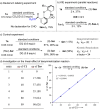Synthesis of axially chiral diaryl ethers via NHC-catalyzed atroposelective esterification
- PMID: 38516093
- PMCID: PMC10952084
- DOI: 10.1039/d3sc06444a
Synthesis of axially chiral diaryl ethers via NHC-catalyzed atroposelective esterification
Abstract
Axially chiral diaryl ethers bearing two potential axes find unique applications in bioactive molecules and catalysis. However, only very few catalytic methods have been developed to construct structurally diverse diaryl ethers. We herein describe an NHC-catalyzed atroposelective esterification of prochiral dialdehydes, leading to the construction of enantioenriched axially chiral diaryl ethers. Mechanistic studies indicate that the matched kinetic resolutions play an essential role in the challenging chiral induction of flexible dual-axial chirality by removing minor enantiomers via over-functionalization. This protocol features mild conditions, excellent enantioselectivity, broad substrate scope, and applicability to late-stage functionalization, and provides a modular platform for the synthesis of axially chiral diaryl ethers and their derivatives.
This journal is © The Royal Society of Chemistry.
Conflict of interest statement
There are no conflicts to declare.
Figures




Similar articles
-
Synthesis of Axially Chiral Aldehydes by N-Heterocyclic-Carbene-Catalyzed Desymmetrization Followed by Kinetic Resolution.Angew Chem Int Ed Engl. 2022 Mar 28;61(14):e202117340. doi: 10.1002/anie.202117340. Epub 2022 Feb 15. Angew Chem Int Ed Engl. 2022. PMID: 35100461
-
Enantioselective Synthesis of C-O Axially Chiral Diaryl Ethers by NHC-Catalyzed Atroposelective Desymmetrization.Angew Chem Int Ed Engl. 2023 Dec 21;62(52):e202311709. doi: 10.1002/anie.202311709. Epub 2023 Nov 29. Angew Chem Int Ed Engl. 2023. PMID: 37986240
-
Enantioselective Synthesis of Axially Chiral Diaryl Ethers via NHC Catalyzed Desymmetrization and Following Resolution.Angew Chem Int Ed Engl. 2024 Jan 22;63(4):e202314228. doi: 10.1002/anie.202314228. Epub 2023 Dec 11. Angew Chem Int Ed Engl. 2024. PMID: 38019184
-
Transition-metal-catalyzed atroposelective synthesis of axially chiral styrenes.Chem Commun (Camb). 2023 Oct 24;59(85):12669-12684. doi: 10.1039/d3cc03592a. Chem Commun (Camb). 2023. PMID: 37807950 Review.
-
Advances in Atroposelectively De Novo Synthesis of Axially Chiral Heterobiaryl Scaffolds.Molecules. 2022 Dec 3;27(23):8517. doi: 10.3390/molecules27238517. Molecules. 2022. PMID: 36500610 Free PMC article. Review.
Cited by
-
Visible light-mediated organocatalyzed 1,3-aminoacylation of cyclopropane employing N-benzoyl saccharin as bifunctional reagent.Nat Commun. 2024 Oct 16;15(1):8930. doi: 10.1038/s41467-024-53202-8. Nat Commun. 2024. PMID: 39414792 Free PMC article.
-
Catalytic Enantioselective Synthesis of Axially Chiral Diaryl Ethers Via Asymmetric Povarov Reaction Enabled Desymmetrization.Adv Sci (Weinh). 2024 Sep;11(35):e2403125. doi: 10.1002/advs.202403125. Epub 2024 Jul 16. Adv Sci (Weinh). 2024. PMID: 39014550 Free PMC article.
-
Recent advances in organocatalytic atroposelective reactions.Beilstein J Org Chem. 2025 Jan 9;21:55-121. doi: 10.3762/bjoc.21.6. eCollection 2025. Beilstein J Org Chem. 2025. PMID: 39811683 Free PMC article. Review.
-
Desymmetric esterification catalysed by bifunctional chiral N-heterocyclic carbenes provides access to inherently chiral calix[4]arenes.Nat Commun. 2025 May 13;16(1):4443. doi: 10.1038/s41467-025-59781-4. Nat Commun. 2025. PMID: 40360493 Free PMC article.
References
-
- Chen Y. Yekta S. Yudin A. K. Chem. Rev. 2003;103:3155–3212. doi: 10.1021/cr020025b. - DOI - PubMed
- Akiyama T. Chem. Rev. 2007;107:5744–5758. doi: 10.1021/cr068374j. - DOI - PubMed
- Tang W. Zhang X. Chem. Rev. 2003;103:3029–3070. doi: 10.1021/cr020049i. - DOI - PubMed
- Parmar D. Sugiono E. Raja S. Rueping M. Chem. Rev. 2014;114:9047–9153. doi: 10.1021/cr5001496. - DOI - PubMed
-
- Cheng J. K. Xiang S. H. Li S. Ye L. Tan B. Chem. Rev. 2021;121:4805–4902. doi: 10.1021/acs.chemrev.0c01306. - DOI - PubMed
- Carmona J. A. Rodríguez-Franco C. Fernández R. Hornillos V. Las-saletta J. M. Chem. Soc. Rev. 2021;50:2968–2983. doi: 10.1039/D0CS00870B. - DOI - PubMed
- Cheng J. K. Xiang S. H. Tan B. Acc. Chem. Res. 2022;55:2920–2937. doi: 10.1021/acs.accounts.2c00509. - DOI - PubMed
- Zhang H. H. Shi F. Acc. Chem. Res. 2022;55:2562–2580. doi: 10.1021/acs.accounts.2c00465. - DOI - PubMed
- Qin W. Liu Y. Yan H. Acc. Chem. Res. 2022;55:2780–2795. doi: 10.1021/acs.accounts.2c00486. - DOI - PubMed
-
- Feng J. Li B. He Y. Gu Z. Angew. Chem., Int. Ed. 2016;55:2186–2190. doi: 10.1002/anie.201509571. - DOI - PubMed
- Zheng S. C. Wu S. Zhou Q. Chung L. W. Ye L. Tan B. Nat. Commun. 2017;8:15238. doi: 10.1038/ncomms15238. - DOI - PMC - PubMed
- Hu P. Hu L. Li X. X. Pan M. Lu G. Li X. Angew. Chem., Int. Ed. 2023;63:e202312923. doi: 10.1002/anie.202312923. - DOI - PubMed
LinkOut - more resources
Full Text Sources

